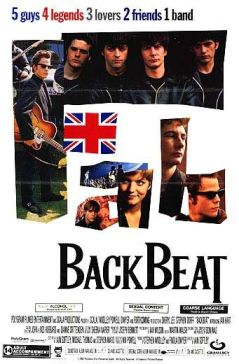 Rating: 5 / 10
Rating: 5 / 10
Long before Ringo Starr was a Fab Four fixture, or before Love Me Do became their first hit single… before John Lennon proclaimed that the band was more popular than Jesus, or before they were slumming around India with the Maharishi… before their Magical Mystery Tour debacle of a film and the eclectic genius of the White Album… the early Beatles shined brightly with Stu Sutcliffe, their original bass player and art-school buddy of John Lennon. Stu traveled with the Beatles to Hamburg as the scrappy young quintet (featuring Lennon, Paul McCartney, and George Harrison, each on vocals/guitar, Sutclife on bass, and Pete Best on drums) cut their rock-and-roll teeth in seedy club after seedy club, opening for burlesque shows, popping uppers like Pez, and sleeping with fans with wanton rock abandon.
But Sutcliffe, a talented artist whose bass-playing abilities were barely marginal at best, really found his passion in the art world. A pretty boy with a James Dean-esque demeanor, he became more enamored of the Hamburg art scene and his burgeoning relationship with local painter and photographer Astrid Kirschherr. Stu eventually left the band (with McCartney taking over bass duties) and moved in with Astrid as the Beatles returned to Liverpool. On April 10, 1962, Stu Sutcliffe collapsed from a brain hemorrhage in Astrid’s apartment and died in her arms. The Beatles arrived the very next day to start another Hamburg tour.
Beatlemaniacs worldwide are intimately familiar with the tragic stories of Stu and John as well as Stu and Astrid, for both are intrinsically linked together. This triangle sets the scene for Backbeat, director’s Iain Softley’s affectionate and beautifully-staged 1994 drama chronicling the conflict between Sutcliffe, Lennon, and Kirschherr, set against the genesis of what would become the world’s greatest pop band.
The result is, rather disappointingly, a mixed bag. Many parts of the film are positively thrilling and compelling, but the bulk of the movie is weighed down in pointless, often pretentious melodrama. Backbeat is by no means a bad film, but it lacks the kind of dramatic weight to really make it compelling or memorable to anyone outside of the fiercest Beatle fan, and even then it’s slim pickings.
Visually, the film itself is quite a wonder. Softley assembled a group of actors who seem to capture the essence of the Beatles while not being quite picture perfect. Ian Hart’s John Lennon is overflowing with the acerbic wit, capricious hurtfulness, and burning self-righteousness that became pop-culture earmarks of the “witty” Beatle (Hart had also played John Lennon in 1991’s The Hours and Times, a fictional recount of a may-have-been relationship between Lennon and Beatles manager Brian Epstein.) Stephen Dorff is equally impressive as Sutcliffe; he certainly looks the part, but he also imbues his character with sensitivity and charisma. Sheryl Lee’s performance as Astrid completes the triangle with probably the best performance of the three, radiating beauty and softness tempered with iron and gentle austerity.
The rest of the cast are basically supporting roles. In the case of the Beatles bandmates, Gary Bakewell as Paul McCartney and Chris O’Neill as George Harrison look and sound just enough like their roles to be effective, but in this film they are minor personalities. Scot Williams’s performance as Pete Best is, like a good rock drummer, sturdy, solid, and steady. But then again, how many people could really spot a grossly inaccurate Pete Best? Visually the film is also quite remarkable; the reproduction of early 60s Hamburg looks and feels believable.
But where Backbeat loses its step is in its storytelling. Its focus is on the triangle between the three principals. The film (not so subtly) implies that Lennon is also in love with Sutcliffe and jealous of Astrid, but there remains a not-quite-so intangible attraction between Lennon and Astrid as well. This stand-off is never presented in a richly delineated or compelling manner. The movie is really concerned with Sutcliffe, but the character lacks the weight to truly anchor the film. Indeed, the only compelling aspect of his story is the fact that he just missed becoming a Beatle, preferring Astrid and his art to rock-and-roll, which is fine and dandy but not especially interesting.
More intriguing to the viewer is witnessing the emergence of the Beatles from club rats to pop/rock gods, but that isn’t the story, it’s the setting. About halfway into the film, Backbeat gradually shifts from a dynamic reenactment of pseudo-rock legend into a perfunctory tale of living fast, burning brightly, dying young, and the ensuing if grossly ponderous immortalization of tragic beauty.